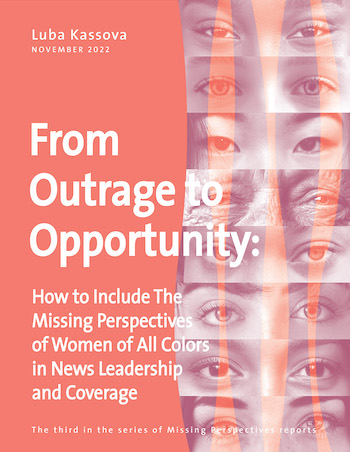Groundbreaking Workshop on AI and Technology-Facilitated Gender-Based Violence at AWiM24
Trending
Monday May 12, 2025
Trending

Women remain significantly underrepresented in editorial leadership roles and news coverage, their voices muted in an industry dominated by men.
In countries with multi-racial populations, women of colour experience even greater marginalisation in news leadership and coverage. This culture of exclusion has had a knock-on effect on women’s news consumption which is in significant decline. Yet, according to a new report published today, greater engagement by women could revitalise the news industry and generate billions of dollars of additional revenue.
From “Outrage to Opportunity: How to Include the Missing Perspectives of Women of All Colors in News Leadership and Coverage” by Luba Kassova provides a comprehensive, solutions-focused examination of the harsh realities facing women of all colours in six focus countries (India, Kenya, Nigeria, South Africa, the UK and the US).
The report contains the most extensive research ever carried out on why women are marginalized in news and how to change that. It also presents a compelling business case for addressing the gender gap in news consumption, which outlines a multi-billion-dollar opportunity for a struggling global news industry through increased revenues from women’s news audiences.
“Women’s position in news leadership and coverage revealed in this report is a source of outrage and hope,” said Luba Kassova, Report Lead Author, Co-Founder and Director, AKAS. “Outrage because women are still severely sidelined as top editors and news protagonists, while women in multi-racial societies are suffering unfathomable exclusion in leadership and their stories are routinely missed and hope because, if brought in from the sidelines, women can be a lifeline for the news industry.”
Editorially not enough women are making it to the top of news.
The report explains how the perception that progress is being made, which tends to follow every high-profile appointment of a woman in journalism, cannot withstand closer scrutiny.
In analysing 1,166 editorial roles, the report found that for every woman who is an editor-in-chief, there are between two (in South Africa, the USA and the UK) and 12 (in Indian regional news outlets) male editors-in-chief.
Women are also seriously underrepresented in editorial leadership in high-profile news beats, such as politics, economics/business, and foreign affairs, where they can hold as few as 1 in 6 editorial roles. Although women have achieved gender parity among the most senior editors in health beats across five of the six countries, on average in business and politics beats only 1 in 3 and 1 in 4 are women. Similarly, 1 in 3 foreign affairs editors in the UK and the US are women.
Women of colour face even more profound challenges in journalism.
Women of colour in the three multi-racial countries featured in the report (South Africa, the UK, and the US) experience even greater marginalisation or outright exclusion from news leadership roles because they endure racial barriers on top of the barriers that all women experience. If people of colour were represented in senior positions in proportion to their percentage in the working population, their numbers in these roles would be 3 times higher in the US, 2.2 times higher in South Africa, and 1.2 times higher in the UK.
In the UK, no women of colour occupy the most senior editorial positions in politics, foreign affairs, and health news beats; in South Africa, just 29 per cent of political editors are women of colour, while their proportion in the population is 46 per cent. Women of colour are severely marginalized in the US compared to their proportion in the working population: 3 per cent, 4 per cent, 6 per cent and 9 per cent of the political, foreign, health, and economics/ business editors in the US are women of colour, which is 7, 5, 4, and 2 times fewer than their proportion in the working population.
The women of colour with editorial experience interviewed for the report perceived newsrooms as being fearful or unwilling to deal with issues around lack of diversity or cultural exclusion. Consequently, women of colour often find themselves faced with the impossibly onerous expectation that they should resolve the problem of their own underrepresentation and exclusion from newsrooms and leadership.
Stories about women’s experiences are being lost.
In news content, there is a huge gap in the coverage of issues that affect women disproportionately compared to men. News either fails to cover sufficiently or omits altogether, the seven substantive gaps in which men enjoy an unfair advantage over women: gaps in power, pay, safety, authority, confidence, health and ageism.
Less than 1 in 5000 news stories globally between 2017 and April 2022 featured any reference to these gaps, with over 90 per cent of such coverage focusing exclusively on the pay gap. The situation has worsened as a result of the COVID-19 pandemic. Global news coverage on gender equality issues declined from 0.56 per cent pre the pandemic outbreak to 0.44 per cent since.
The report outlines 12 solutions themes that cover every aspect of the news industry, from strategy to practical day-to-day interventions. These include – among others – a focus on auditing, target setting and measuring representation across the entire news value chain; tracking and improving the inclusion of women of all colours in news leadership and key decision-making roles; looking for story angles that appeal to both women and men, and increasing coverage of seven gender gaps. Adopting the proposed solutions would improve the representation and inclusion of women of all colours in news strategy and leadership and create more balanced and inclusive coverage.
Journalism is short-changing women audiences and losing billions as a result. But it need not be this way.
There is a compelling business-case argument for addressing the news consumption gender gap in a global newspaper industry set to experience brutal declines in its revenues in the next decade. Using multiple sources, the report estimates that the newspaper industry’s revenues will be almost one-quarter smaller in 2032 ($69bn), compared to 2022 ($90bn). People’s consumption of news is declining, in part driven by women having less interest in or actively avoiding news. But this need not be the case in the future.
Based on an analysis of nearly 1,700 individual news websites globally and incorporating the results of the Reuters Institute for the Study of Journalism’s Digital News Report 2022 survey of 93,000 respondents, the report estimates that there is an addressable 11-12 percentage point gender consumption gap between men and women in the newspaper industry. Closing this gap by just one percentage point each year, starting in 2023, would yield additional cumulative revenues of $11 billion over five years and $38bn over 10 years globally. For the six focus countries over the next five years, this would yield $487m for India; $11m for Kenya; $10m for Nigeria; $38m for South Africa; $413m for the UK; and $2.7bn for the US.
“The financial argument should not be the only reason to aim for gender parity,” said Richard Addy, Lead Researcher, Co-Founder and Director, AKAS, “however for those news organizations that make a concerted effort to improve their performance in relation to women in terms of leadership, representation, inclusion, portrayal and
coverage, the prize is significant.”
For those news organizations that approach this challenge seriously and strategically, rather than symbolically, there is the significant opportunity to access the untapped multiple millions of dollars that increasing women news audiences would generate.
From Outrage to Opportunity… is a sequel to the award-winning The Missing Perspectives of Women in News/in COVID-19 News reports. All three reports were independently produced and commissioned by the Bill & Melinda Gates Foundation.
We’re not gonna spam. We’ll try at least.

Copyright 2020. African Women In Media
Copyright 2020. African Women In Media
Recent Comments